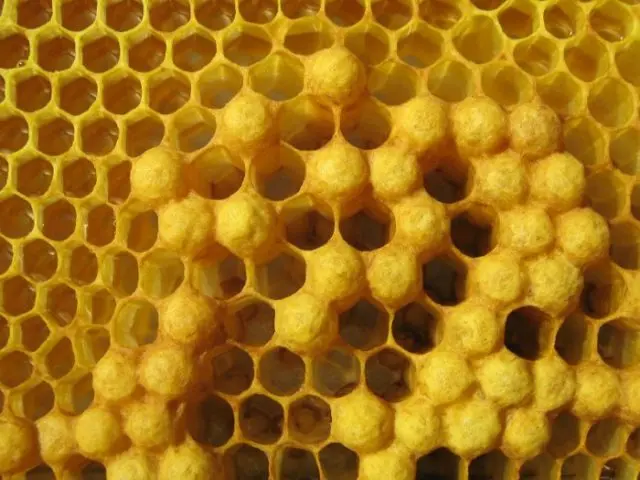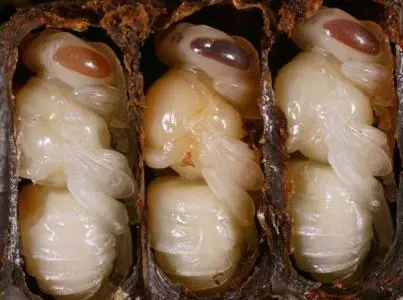Contents
Any novice beekeeper, wanting to delve into all the nuances of bee breeding, one way or another encounters a large number of processes and terms that may seem complicated at first. These include drone brood, which is called one of the mysteries of honey bees, the study of which is an important component of the experience of every beekeeper.
What is brood, its importance in beekeeping
Like many insects, bees, before turning into adults, go through a certain stage of development. In a general sense, the brood is the totality of all the offspring of the bee family, which is also called “children”.
Since the development of a bee colony has its own patterns, by the appearance and number of children in the hive, one can draw a conclusion about the state of the swarm, its health and functionality. A large brood invariably leads to the appearance of young worker bees, which means an increase in honey yield.
Bees are very organized creatures that not only perform their well-defined tasks in the hive, but also have strictly designated areas for both children of different species and for the products of their vital activity. As you can see in the photo, the brood of bees is usually placed in the center, while the food is at the edges.
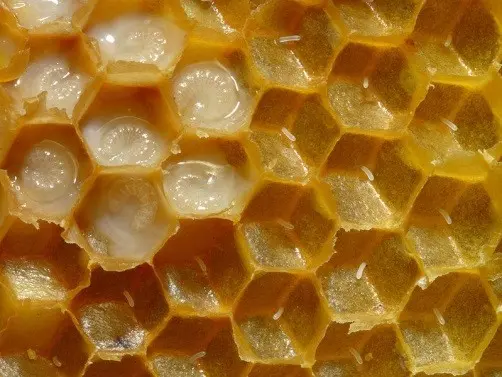
In addition, frames with brood, in contrast to frames with food, have a more convex and rough structure.
What does bee brood look like
Outwardly, the bee brood is a wax cell in which there are bee babies at different stages of growth. Depending on these stages, it can be open and closed.
Open brood is considered to be in unclogged cells, where there are already bee larvae. As a rule, the larvae emerge from the eggs on the third day and look like transparent worms without legs and wings. At this stage, the worker bees feed the babies with bee milk, bee bread and honey in different proportions – until the transition of the larva to the pupal phase. The photo below shows an open brood of bees.

As soon as the baby begins to pupate, the worker bees stop feeding her and seal the cell with a porous wax cap. From this point on, the brood of bees is called printed.
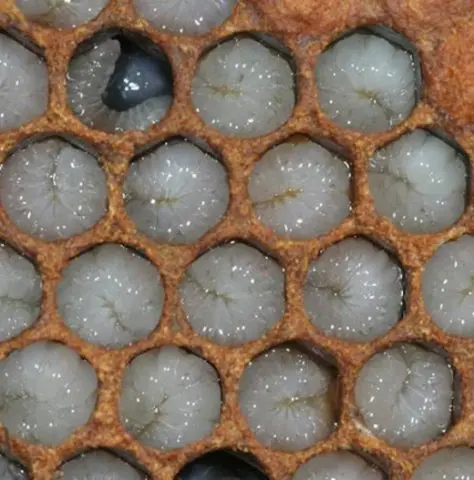
Despite the well-balanced dynamics that exist in the family of bees, it rarely happens that all the children in the hive develop synchronously. Due to changes in temperature and humidity or past diseases, some of the offspring may die, and then the uterus lays new eggs in unoccupied cells. This leads to the appearance in the family of children in sealed and open cells at the same time – the so-called “variegated brood”.
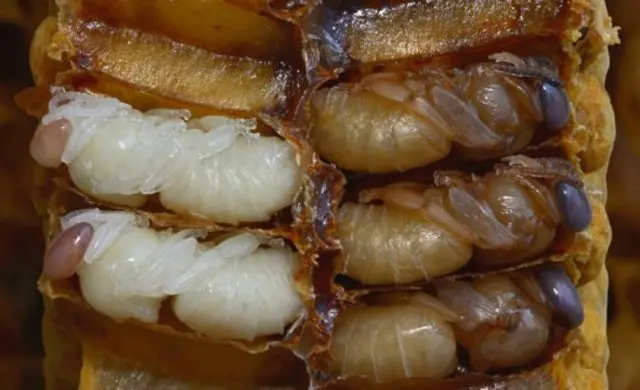
Photos of bee brood by day
Regardless of the breed of bees and their role in the hive, the stages of brood formation can be summarized in the following table:
Stage of development | Duration in days | ||
| Uterus | worker bee | Drone |
Egg
| 3 | 3 | 3 |
Larva
| 5 | 6 | 7 |
Pre-pupa
| 2 | 3 | 4 |
Pupa
| 6 | 9 | 10 |
How to know the daily brood
Having studied the hierarchy of bees, we can conclude that in this complex community, all the actions of the hive members, from the worker bee to the queen, are subject to a certain algorithm, which is regularly repeated in a healthy family. Therefore, it will not be difficult for an experienced beekeeper to determine the age of children of any type with an accuracy of up to a day.
So, the uterus, when laying eggs – scarring – places the offspring at the bottom of the combs, one egg in each cell. The one-day brood of bees is located vertically in the cell, as in the photo, but as it develops, it acquires a horizontal position by the time a larva emerges from it.
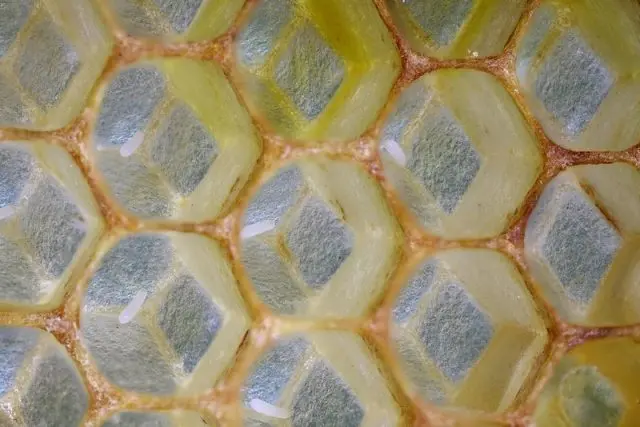
On what day do bees seal the brood
Bee larvae immediately after hatching from the egg begin to feed intensively under the supervision of working insects. Moreover, the type of food for children directly depends on their future role in the family. By the end of the third day, the children are much larger in size. The worker bees then stop feeding the exposed brood and seal the entrance to the cell to complete the baby-to-adult process.
When the last brood of bees comes out in autumn
In healthy communities of bees with a functional queen no older than 2 years, babies appear from spring, after the insects leave wintering, until the end of summer. The last brood comes out, as a rule, in late August – early September. By this time, they usually stop feeding the bees for the winter and move on to cleaning the nests.
Types of bee brood
Depending on the type of eggs sown in honeycombs by the queen, bee brood is divided into 2 types:
- worker bees;
- drone.
Since worker bees make up the bulk of the family, their brood accounts for most of the comb. The worker bee emerges from eggs fertilized by drones and takes 21 days to complete its development from baby to adult.
Drone brood are bee babies, from which male bees, called drones, will subsequently grow. Their stages of development are similar to those of the worker bees, but take longer, 24 days in total. In addition, they hatch from an unfertilized seed. Drones do not carry other functions, except for the fertilization of the uterus. Below is a photo of the drone brood.
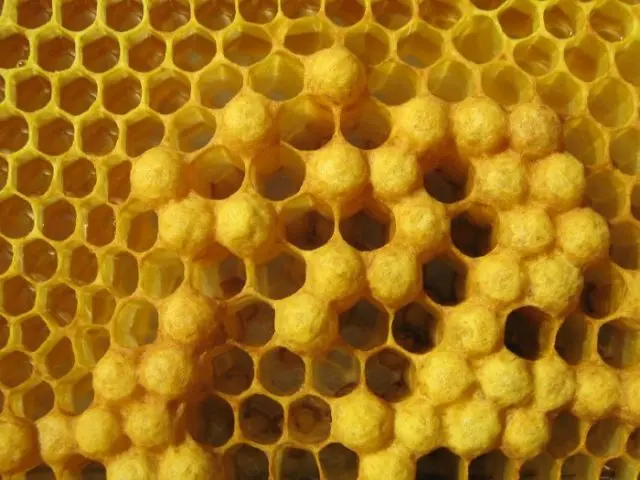
After how many days does the printed brood come out
As can be seen from the diagram above, the emergence of printed brood, and, consequently, the transformation of the baby into an adult insect, is associated with the role of the bee in the community. So, the queens need only 6 days for a complete metamorphosis from a pupa to a mature individual – this is the shortest cycle. Worker bees need a little more time – 9 days. Drones are subject to the longest transformation: 10 full days.
Brood diseases
With insufficient care, a swarm of bees can be exposed to various diseases, which in most cases affect bee offspring. Among the most common diseases are:

- sac brood – a viral infectious disease affecting 3-day-old larvae. The virus enters the hives from wild bees and bee pests and is transmitted through the beekeeper’s infected inventory. Symptoms include clouding of the color of the children and their gradual darkening from the head. Then the bee larvae completely blacken and dry out. When such a diagnosis is established, the affected combs and babies are destroyed, and the queen is removed from the bee family for 1 week to stop egg laying. Hives, combs with fodder honey, inventory and other things that have been in contact with an infected swarm are disinfected. The swarm of bees is treated with a 3% solution of potassium permanganate in a ratio of 100 ml per 1 frame.Important! Potassium permanganate should not fall on open brood, otherwise some of the children will die.
- lime brood, or axospherosis – a contagious disease caused by spores of a mold variety of fungi. In the course of the disease, the body of the baby bee begins to become covered with mold, become shiny, acquires an off-white color and hardens. After that, the fungus captures the entire space of the honeycombs, mummifying the larva. If symptoms of the disease are detected, cells with sick offspring are sent to a veterinary laboratory. Infected combs and dead bees are removed from diseased colonies. The nest is cleaned, insulated and ventilated. For treatment, antibiotics nystatin and griseofulvin (500 OD per 000 liter of sugar syrup) are used – 1 g per 100 frame, 1 time in 1 days. The general course of treatment is 5 days.
- stone brood, or aspergillosis – an infectious disease that affects children and adult bees. It is caused by two types of fungi of the genus Aspergillus: black and yellow. When the honeycomb is infected, the larvae and bees are covered with fluffy mold of the corresponding color. Treatment is carried out in the same way as with axospherosis.
In addition to the above ailments, there are also lattice and humpback brood. They are not classified as diseases, but as violations of the vital activity of individual hives, which can be corrected with due diligence.
Thus, lattice brood occurs for a number of reasons, the most common of which is the presence of a diseased or old queen, which does not sow the cells with eggs so densely. Because of this, unevenly spaced empty cells remain. The problem is solved by replacing the uterus with a younger individual.
Humpback brood requires more detailed consideration due to its specificity.
What is “humped brood” in bees
This is a phenomenon in which the queen bee lays drone eggs in cells intended for eggs, from which worker bees subsequently hatch. Such cells are small and unable to accommodate the entire male bee pupa, which is why, when sealed, the lid takes a curved shape, as if forming a hump. Male bees from the affected cells come out deformed and small compared to healthy drones.
From time to time, such brood in small quantities can be seen in full-fledged functional queens, most often in early spring. As a rule, soon the life of the colony returns to normal, and the children begin to develop normally.
But if the trend is prolonged, this is a sign that the uterus, for some reason, has lost the ability to lay eggs or died. Then, after about 2 weeks, part of the worker bees acquires the ability to lay eggs. However, unlike the queen, they can only worm with drone brood, for which they are called tinder bees. In addition, tinderers cannot distinguish between drone combs and worker breeding cells, which is why humpbacked brood is formed.
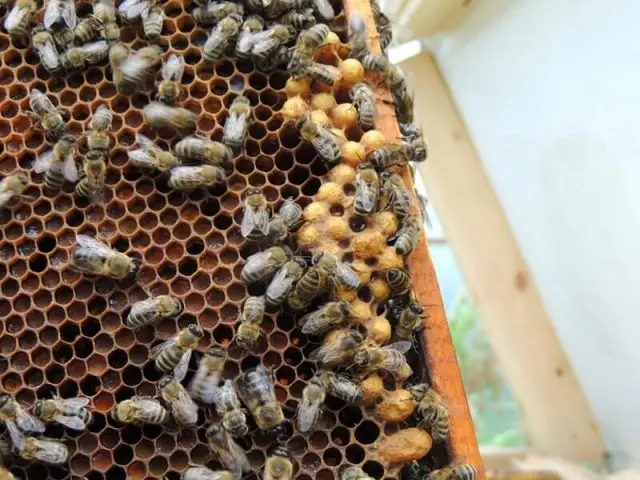
Humpback brood in bees can be identified by the following signs:
- combs in open brood are smaller than the larvae in them;
- closed brood has a convex surface;
- there are several eggs in one cell;
- eggs are located not at the bottom, but on the walls of the cells.
How to fix humpback brood in bees
To eliminate this anomaly, there are several ways that depend on the size of the bee family and the season when the violation manifested itself.
So, a small swarm of bees (up to 6 frames) would be more reasonable to disband or settle for wintering with a larger family.
In the case of large communities, you need to act according to the following scheme:
- Move 1 – 2 frames with a clutch of a strong swarm.
- Transplant from the same queen with several bees, which will accelerate its adaptation.
- Remove the humpback brood from the frames and return them to the hive.
Many beekeepers use a different method:
- Frames with disturbed brood are taken some distance from the hive and the babies are shaken out, thoroughly cleaning the combs.
- Then replace the old hive with a new one. After some time, a swarm of bees will settle down in an unusual place, leaving drone flightless queens outside.
What to do if there is no brood in the hive
Often, beginner beekeepers are faced with a situation where, it would seem, there are no signs of disease, but there is no brood in the hive. This can happen for several reasons:
- the uterus is dead;
- the uterus is weakened or too old to continue laying eggs;
- there is not enough food for the bees in the hive.
In the first case, it is enough to add a family of bees to another swarm in which there is a queen, or to plant a young fetal queen in a queenless family. With this method, it is better to use a special cage: this will help the queen adapt to a change in the situation and protect her if the bees react aggressively to a new family member.
If there is a queen in the hive, but does not worm and there is no brood, this may be due to her age. As a rule, the queens retain the ability to lay eggs for 2 years, but in multi-level hives, where the load is several times higher, the queens need to be replaced annually.
If there is no brood in August, this may be due to the early transition of the bee colony to the winter regime. It usually happens at the beginning of September: at the same time, the last babies come out of the sealed honeycombs. However, the start of overwintering may shift to mid-August if there is not enough food in the hive to feed the brood. To solve this problem, it is enough to feed the swarm with syrup – and then the uterus will return to its duties.
The value of brood to humans
In addition to its undoubted value directly for beekeepers, bee brood is also of interest to people who are very far from breeding bees.
So, some African tribes regularly eat it. Despite the fact that this dish is extremely exotic, it is a rich source of protein and can compete with meat in its content. In addition, it contains a huge amount of vitamin D and various mineral compounds, including calcium, phosphorus, copper, zinc and sodium. It also contains more than 30 amino acids, which are involved in all processes of the human body and strengthen the immune system.
Often, bee babies and other bee products are used in apitherapy to treat endocrine and prostate disorders, female and male infertility, and to alleviate the symptoms of menopause.
Larval milk has proven its usefulness in cosmetology. It is included in anti-aging masks and creams due to its anti-aging properties.
Conclusion
Both bee and drone brood are of great importance. For beekeepers, it serves as an indicator of the health and proper functioning of the bee colony, while a simple layman will appreciate its medicinal and cosmetic properties.










